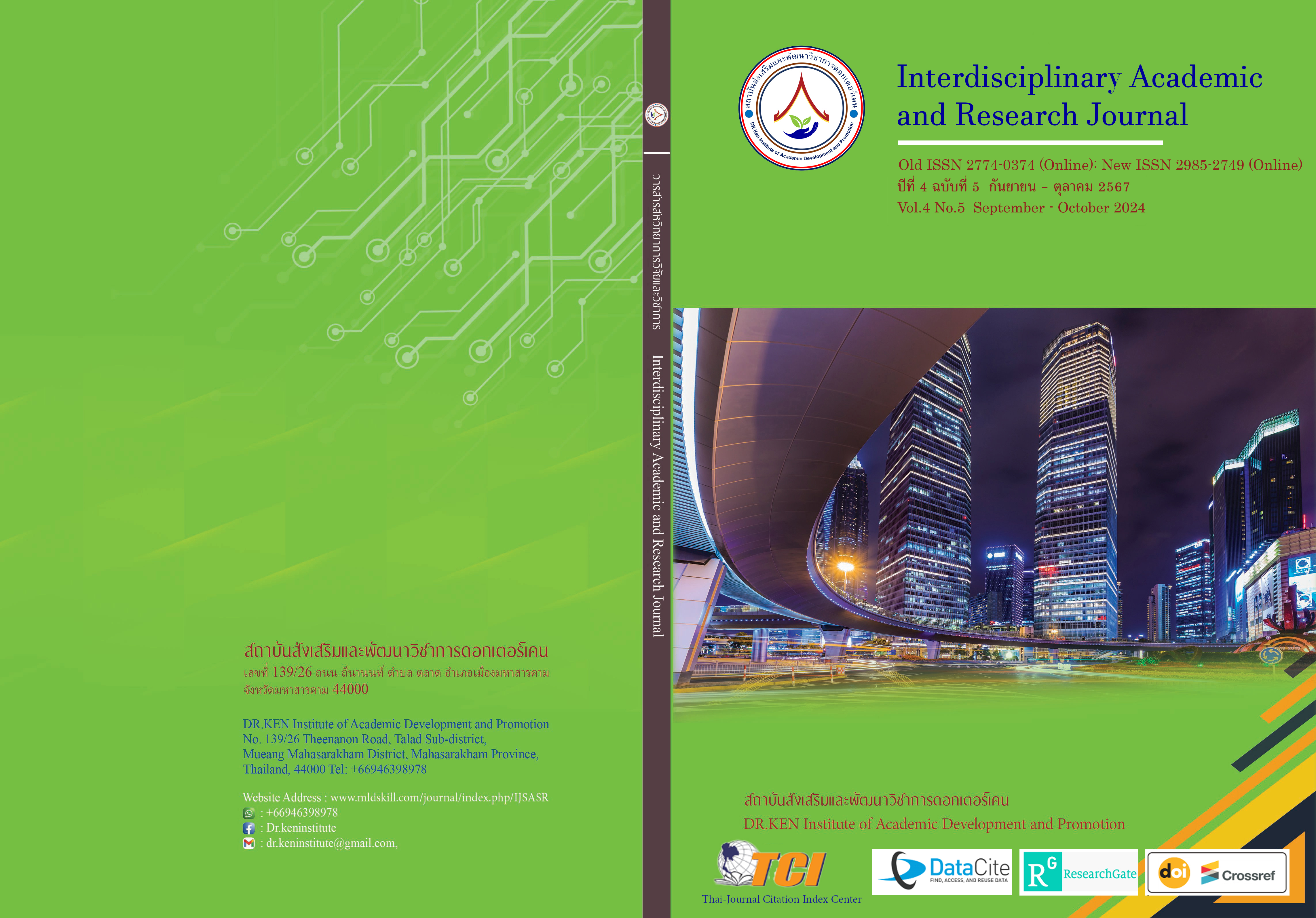Vocational Education Administration, Bilateral System under the Office of the Vocational Education Commission Kalasin Province
DOI:
https://doi.org/10.60027/iarj.2024.276489Keywords:
Vocational education management; , bilateral system; , Office of the Vocational Education Commission Kalasin ProvinceAbstract
Background and Aims: Vocational education administration Dual system of educational institutions under the Office of the Vocational Education Commission. It is a professional education arrangement that arises from an agreement between an educational institution and a business establishment. The main objective is to develop and train professional skills for students. To prepare for future work the objectives of this research are to study the following: (1) Level of administration of vocational education, dual system, of vocational education in Kalasin Province. According to the standards for managing vocational education in the dual system of the Vocational Education Commission. To assess the quality and efficiency of operations at the operational level. 2) Compare the level of vocational education administration in the dual system of vocational education in Kalasin Province. To find differences in management in various areas and the use of various approaches to develop educational quality. (3) Study guidelines for promoting or developing the administration of vocational education, a dual system, of educational institutions under the Office of the Vocational Education Commission, Kalasin Province. To suggest ways to improve and develop educational administration to be more efficient.
Methodology: In this research the sample group used was a total of 196 people. The research tool was a questionnaire with a 5-level rating scale, which had a confidence value of 0.81 and an internal consistency (IOC) in the range of 0.6-1.00. This questionnaire was designed to inquire about the administration of vocational education. Dual system of educational institutions under the Kalasin Provincial Vocational Education Institute. For data analysis use basic statistics, including frequency, percentage, mean, standard deviation and statistical tests used to compare differences, including t-test and F-test.
Results: The results of the research found that: (1) Vocational education administration overall, it was at a high level. (2) Results of comparative analysis of opinions regarding vocational education administration classified by position, educational level, and size of educational institution found that there was no difference. (3) Guidelines for developing vocational education administration It is necessary to be supported and encouraged to be able to develop and adapt to the changes in today's industrial world. The various areas that should be developed include: 1) Quality of graduates: They must have knowledge and abilities that are accepted by the industry. 2) Curriculum development: Curriculum should be developed together with entrepreneurs and other stakeholders. 3) Measurement and evaluation: An effective measurement and evaluation system should be developed. 4) Cooperation between Educational institutions and business establishments: There should be strong relationships and cooperation in developing students.
Conclusion: Vocational education administration Dual system of educational institutions under the Office of the Vocational Education Commission Kalasin Province. It is necessary to strengthen cooperation between educational institutions and enterprises. By giving the private sector an opportunity to participate in setting criteria and guidelines in various areas to be clear and consistent with the needs of the labor market. In this regard, there should be an effective evaluation process in order for management to be systematic and produce good results.
References
กฤติกา ไหวพริบ และคณะ. (2561). การบริหารการศึกษาระบบทวิภาคีโรงเรียนป้อมนาคราชสวาทยานนท์ จังหวัดสมุทรปราการ. วารสารครุศาสตร์ปริทรรศน์, 5 (3), 97-106.
จอมพงศ์ มงคลวนิช. (2561). การบริหารอาชีวศึกษาระบบทวิภาคี. พิมพ์ครั้งที่ 1. กรุงเทพฯ : สำนักพิมพ์แห่งจุฬาลงกรณ์มหาวิทยาลัย.
ธานินทร์ ศรีชมพู และคณะ. (2557). การพัฒนารูปแบบการบริหารงานอาชีวศึกษาระบบทวิภาคีในสถานศึกษาสังกัดสำนักงานคณะกรรมการการอาชีวศึกษา. วารสารศึกษาศาสตร์มหาวิทยาลัยนเรศวร, 16(3), 120 – 121.
นงนุช เพ็ชรชนะ. (2559). การบริหารจัดการอาชีวะศึกษาระบบทวิภาคีของวิทยาลัยเกษตรและเทคโนโลยีลำพูน. วิทยานิพนธ์ปริญญาศึกษาศาสตร์มหาบัณฑิต. ลำปาง: มหาวิทยาลัยเนชั่น.
นวลอนงค์ ธรรมเจริญ. (2558). การพัฒนารูปแบบการบริหารจัดการอาชีวศึกษาระบบทวิภาคี โรงเรียนในโรงงานแบบบูรณาการ. ปริญญานิพนธ์ ปร.ด. (บริหารเทคนิคศึกษา). กรุงเทพฯ : บัณฑิตวิทยาลัย มหาวิทยาลัยเทคโนโลยีพระจอมเกล้าพระนครเหนือ.
บัณฑิต ออกแมน. (2560). การพัฒนารูปแบบความร่วมมือการจัดการอาชีวศึกษาระบบทวิภาคีระหว่างสถานศึกษาสังกัดสำนักงานคณะกรรมการการอาชีวศึกษากับนิคมอุตสาหกรรมอมตะนคร. วิทยานิพนธ์. มหาวิทยาลัยเทคโนโลยีพระจอมเกล้าพระนครเหนือ.
บุญชม ศรีสะอาด. (2556). การวิจัยเบื้องต้น. พิมพ์ครั้งที่ 9. กรุงเทพฯ : สุวีริยาสาส์น.
พระราชบัญญัติการอาชีวศึกษา. (2551). ราชกิจจานุเบกษา. เล่ม125. ตอนที่ 43 ก. หน้า 1 - 24.
วรรณดี สุทธินรากร และภูวเรศ อับดุลสตา. (2561). การพัฒนาระบบทวิภาคีของการอาชีวศึกษา. พิมพ์ครั้งที่ 1. กรุงเทพฯ : สยามปริทัศน์.
สำนักงานคณะกรรมการการศึกษาแห่งชาติ. (2545). พระราชบัญญัติการศึกษาแห่งชาติ พ.ศ. 2542 และที่แก้ไขเพิ่มเติม (ฉบับที่ 2) พ.ศ. 2545. กรุงเทพฯ : สำนักงานฯ.
สุทธิรักษ์ ทัศบุตร. (2564). การบริหารการศึกษาอาชีวศึกษาระบบทวิภาคี ของสถานศึกษาในสังกัดสำนักงานคณะกรรมการการอาชีวศึกษา. วารสารบริหารการศึกษาบัวบัณฑิต, 21(1), 59-66.
อาทิตย์ จิรวัฒนผล. (2553). การอาชีวศึกษาระบบทวิภาคี. Retrieved November 2, 2022. from https://www.gotoknow.org/posts/321903.
Krejcie, R.V., & Morgan, D.W. (1970). Determining sample size for research activities. Education and Psychological Management, 30(3), 607-610.
Downloads
Published
How to Cite
Issue
Section
License
Copyright (c) 2024 Interdisciplinary Academic and Research Journal

This work is licensed under a Creative Commons Attribution-NonCommercial-NoDerivatives 4.0 International License.
Copyright on any article in the Interdisciplinary Academic and Research Journal is retained by the author(s) under the under the Creative Commons Attribution-NonCommercial-NoDerivatives 4.0 International License. Permission to use text, content, images, etc. of publication. Any user to read, download, copy, distribute, print, search, or link to the full texts of articles, crawl them for indexing, pass them as data to software, or use them for any other lawful purpose. But do not use it for commercial use or with the intent to benefit any business.
















.png)


